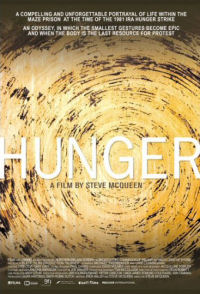|
 Steve McQueen’s “Hunger” is exceptional, innovative filmmaking. Its explosive, Steve McQueen’s “Hunger” is exceptional, innovative filmmaking. Its explosive,
graphic view of prison life can make it a very difficult film to view but I highly recommend it. It has been a huge success on the “legit” festival circuit, namely winning the Camera D’or at Cannes. It opens at Laemlle’s March 27. “Hunger” takes place in the Maze Prison in Northern Ireland during the height of the Thatcher Era violence. Among the prisoners in H-Block is Bobby Sands, who eventually brings his plight to the world via his heroic hunger strike. The republican prisoners, defined as terrorists by the government, refuse to wear the uniforms of convicts. They protest accepting only blankets and refusing to wash. They concoct an elaborate smuggling operation to obtain communications and then report back to Bobby at Sunday mass. Meanwhile everyman prison guard, Raymond Lohan, is cracking due to the stench and stress of the protest. Prisoners are drawn from their filthy, claustrophobic cells and beaten. The guards are forced to relent and allow the prisoners to wear civilian clothes. In an attempt to humiliate the prisoners, they are given “clown clothes;” all pastels and plaid, A riot erupts and violence builds upon violence, in and outside the prison. Sands consults with a priest and starts the hunger strike. McQueen has stripped away the majority of the dialogue in the film and chooses to tell the story in highly visually style. This result is a series of haunting, internal performances. Stuart Graham’s performance as ‘Raymond’ is a masterpiece of deep thought. He clinically walks through each day of turmoil; his only reprieve is a cigarette outside of the walls. The audience is forced into wondering exactly what is going through this man’s mind when he kisses his wife when going off to work each day. For any actor this is an excellent study on performing without the comfort of a script. This film sends you into a whirlwind of thought. The soundtrack is constrained to the overdubbed words of Margaret Thatcher. It is impossible not to compare the propaganda of the Bush presidency. Your point of view is the only thing that determines the difference between the words “terrorist” and “freedom fighter.” The brutal beatings and mind games stir thoughts of Guantanamo Bay and Abu Ghraib. I found myself contrasting the strategies of waging a successful war. I couldn’t help but comparing the more infamous rebellions of the world: Palestine vs. Israel, Ireland vs. England, India vs. England, U.S. vs. England, Al Qaeda vs. U.S, the African American Community vs, US and so forth. Violent rebellion rarely works and is not efficient. The results The general goal of war is, after all, peace. The tactics used will determine who you are and how you succeed. “Hunger” is a brutal and brilliant imagining of Bobby Sands’ rebellion.
Trackback(0)

|